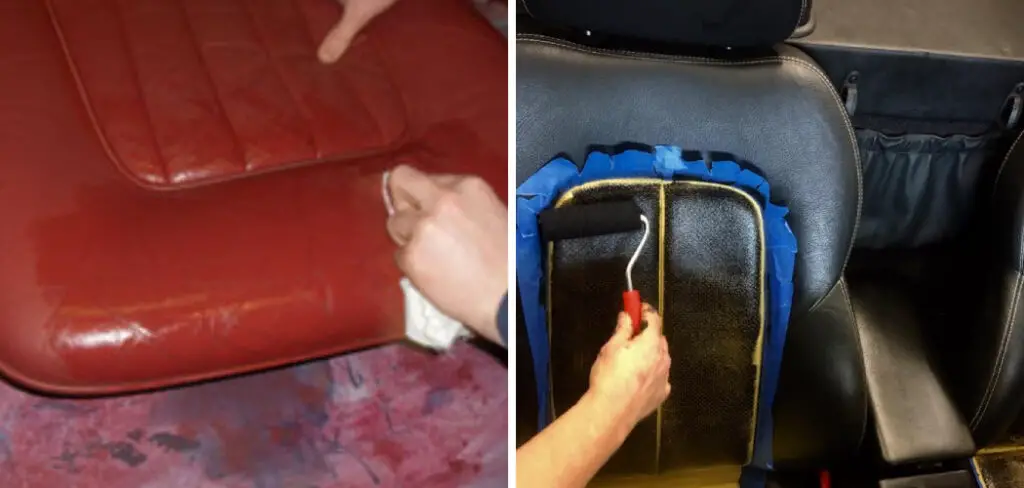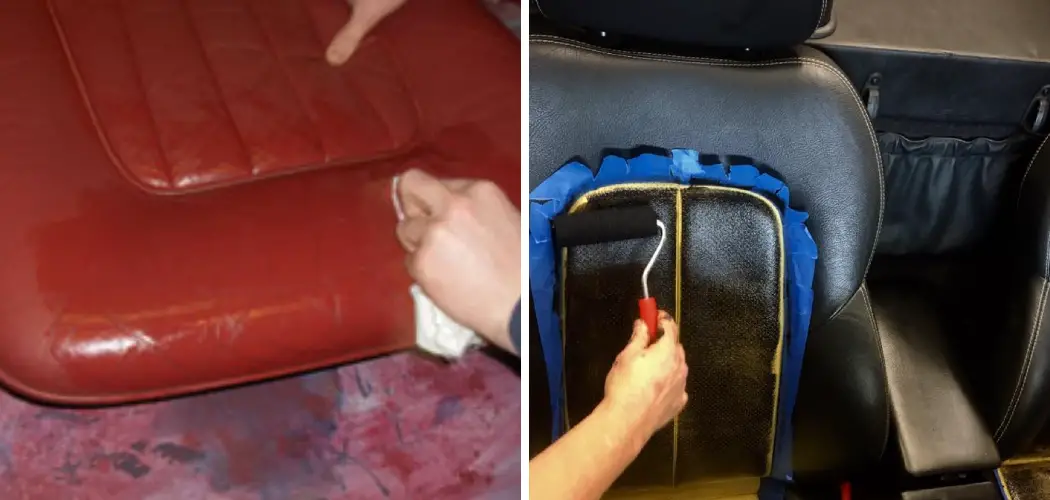Whether you have a new car with leather seats or an old car with worn-out leather, there are many ways to change the color of your leather seats. For example, you can use a store-bought Leatherique kit, Rit dye, or Simply Spray fabric paint.
You can also send your seats out to be professionally reupholstered. If you want to change the color of your leather seats yourself, keep reading to learn more about how to color leather seats.

Can You Color Leather Seats?
Depending on the type of leather, it may be possible to color leather seats. For example, aniline and semi-aniline leather are made from natural fibers that have been dyed, so the color penetrates deeply into the material. As a result, it may be possible to use a leather dye to change the color of these seats.
However, pigmented leather has been treated with a coating that seals in color, making it more resistant to staining. As a result, it is generally not possible to change the color of pigmented leather.
Therefore, before attempting to color any leather seat, it is important to test the dye on an inconspicuous area to ensure that it will not damage the material.
With proper care, it has been possible to keep leather seats looking like new for many years.
Why Should You Color Leather Seats?
When it comes to leather seats, there are a few things that you should keep in mind. First, leather is a natural material, and it is also very porous. This means that it can absorb spills and stains very easily. As a result, it is important to protect your leather seats with a good quality leather conditioner.
Leather conditioners help to seal the pores of the leather, making it more resistant to staining. In addition, they help to keep the leather supple and prevent it from cracking. Leather conditioners can be found at most auto supply stores, and they are relatively inexpensive.
Another option is to color your leather seats. This can help to hide any existing stains or damage, and it can also give your seats a new look. Various leather dyes are available on the market, and you can choose a color that best suits your taste.

Dyeing your leather seats is a relatively simple process, but it is important to follow the directions carefully. Otherwise, you may end up with uneven coloring or even permanent seat damage.
How to Color Leather Seats in 6 Easy Steps
Step 1: Prepping the Seats for Coloring
The first step is deep cleaning the seats using a cleaning solution made specifically for automotive leather. Once
the seats are clean and dry, you need to roughen up the surface so that the dye or paint will adhere properly. Use fine-grit sandpaper for this step.
Be sure to go over the entire seat, paying special attention to any cracked or peeling areas. Wipe away any sanding dust with a tack cloth before proceeding.
Step 2: Applying the Dye or Paint
Now you’re ready to apply the dye or paint of your choice. If you’re using Rit dye, mix it according to the instructions on the package and apply it evenly to the seats using a sponge brush. Allow the dye to dry completely before moving on to the next step.
If you’re using fabric paint, follow the bottle instructions or can. But, again, be sure to apply it evenly and allow it to dry completely before proceeding.
Step 3: Sealing in the Color
Once the seats are colored, you need to seal in the new color with a clear coat of polyurethane or acrylic sealer designed for use on auto leather. This will help protect the new color from fading due to sunlight and wear and tear.
Apply three thin coats of sealer, allowing each coat to dry completely before applying another. Once the final coat is dry, enjoy your new-looking leather seats!
Step 4: Reapply Conditioner

After you’re done coloring and sealing, it’s important to apply a good quality leather conditioner or protectant. This will help keep the leather soft and supple, prolonging its life. Next, apply a thin layer of conditioner over the entire seat, wipe away any excess with a clean cloth, and you’re all done.
Step 5: Reattach Any Removed Parts
If you had to remove any parts of the seats to dye or paint them, reattach them now. Use a strong adhesive designed for automotive leather, and ensure everything is securely attached before you put your car back on the road.
Step 6: Final Cleaning
Before you take your car out for a spin, give the seats one last thorough cleaning with an automotive leather cleaner. This will remove any excess dye or paint and eliminate any lingering dust from sanding. Now your new-looking leather seats are ready to go!
That’s it! You’ve now learned how to color leather seats in six easy steps. With a few simple tools, some patience, and the right products, you can make your car’s interior look new again!
Things You Need to Know Before Coloring Leather Seats
Many people love the look of leather seats, but those seats can be expensive to replace. So if you’re looking for a way to change up the look of your car without breaking the bank, consider coloring your leather seats.
This is a relatively simple process, but there are a few things you need to know before you get started. First, it’s important to choose a dye that is specifically designed for use on leather. These dyes will penetrate the surface of the leather and provide long-lasting results.
Second, make sure to test the dye on a small area of the seat before applying it to the entire surface. This will help you ensure that you’re happy with the color and will evenly cover the leather. Finally, be sure to apply a clear sealant after coloring the seats.

This will help protect the dye job and keep your seats looking new for years to come. With these tips in mind, coloring your leather seats is a great way to give your car a fresh new look.
5 Benefits of Coloring Leather Seats
Leather seats are a luxurious addition to any car, requiring extra care to keep them looking their best. One way to protect leather seats is to color them. Coloring leather seats have several benefits, including:
1. Protection from the Sun:
The sun can damage leather seats, causing them to fade and crack over time. By coloring your seats, you can help to protect them from the sun’s harmful rays.
2. Prevention of Stains:
Leather seats are susceptible to staining, but coloring them can help to prevent this. Colored leather is less likely to show stains than uncolored leather.
3. Increased Durability:
Leather seats can suffer wear and tear over time, but coloring them can help to extend their lifespan. Colored leather is more resistant to scuffs and scratches than uncolored leather.
4. Improved Look:
Coloring your leather seats can give them a fresh, new look. You can choose from various colors to find the perfect shade for your car’s interior.
5. Customization:
Coloring your leather seats allows you to customize your car’s interior and make it unique to you. You can use multiple colors to create a one-of-a-kind look for your car. Overall, coloring your leather seats has many benefits that make it worth the effort. So if you’re looking for a way to protect and improve your car’s interior, consider coloring your leather seats!
Some Common Mistakes People Make When Trying to Coloring Leather Seats
Leather is a durable and beautiful material that can add a touch of luxury to any item. However, leather can be tricky to color, and it’s easy to make mistakes that will damage the material or leave it looking patchy and uneven. Here are some common mistakes people make when trying to color leather:

1. Applying the Wrong Type of Dye:
Leather must be dyed with an aniline dye to achieve even coverage and avoid damage. Other dyes will not penetrate the leather correctly, resulting in an uneven finish.
2. Not Prepping the Leather Properly:
Before dying leather, it is important to clean it thoroughly and remove any dirt, grease, or other contaminants. Otherwise, the dye will not adhere correctly and may cause the leather to stain or discolor.
3. Applying too Much Pressure:
When applying dye to leather, be sure to use gentle strokes and avoid putting too much pressure on the brush. Too much pressure can cause the dye to penetrate too deeply into the leather, resulting in a dark and uneven finish.
4. Not Allowing the Dye to Dry Completely:
Once you have finished applying it, allow plenty of time to dry before using or wearing the item. Otherwise, the dye may rub off your clothing or skin.
5. Using low-quality Dye:
In order to achieve a professional-looking finish, it is important to use high-quality aniline dye designed specifically for coloring leather. Low-quality dyes will not penetrate the leather correctly and may fade quickly over time.
Frequently Asked Questions
Can I Paint Leather Seats?
Leather seats are a popular choice for car interiors, and for good reason. They’re comfortable, stylish, and weather resistant. However, like any other type of upholstery, painting leather seats can be a challenging task.
The first thing you’ll need to do is prep the surface. This will involve cleaning the leather and removing any debris or oils that may have built up over time. Once the surface is clean, you’ll need to decide on your paint palette. You can use a variety of paints to achieve different looks, but be sure to test a small area first to make sure the paint will adhere well.
Once the paint is applied, you’ll need to wait for it to dry. The drying time will depend on the type of paint you’re using and the climate where you live. Be patient – it should only take a few hours for complete drying. Once it’s dry, you can begin to apply the final touches by sanding and polishing the surface.
Is It Better to Dye or Paint Leather?
It depends on the specific situation and preferences of the individual. Dyeing leather can provide more consistent color throughout the piece, while painting leather may give the appearance of a more natural finish. Ultimately, it is up to the individual to decide which option they prefer.
Should You Oil Leather Before Dyeing?
The results of dyeing and oiling leather may vary depending on the specific dye and oil used, the type of leather, and the conditions in which the leather will be used. Some users may prefer to oil leather before dyeing in order to increase durability and resist staining. Others may choose to dye leather without oiling it, as the oil may cause the dye to run or fade prematurely. Ultimately,
Does Oiling Leather Make It Darker?
There is no scientific evidence to support the claim that oiling leather makes it darker. In fact, it is possible that oiling may actually make the leather more susceptible to fading and damage. If you are concerned about the appearance of your leather shoes or jacket, it is best to avoid oiling them and instead treat them with a protective coat of wax or sealant.
Conclusion
Coloring your leather seats is a great way to give your car’s interior a fresh, new look without spending much money. You can do it yourself using Rit dye, fabric paint, and a clear sealer designed for auto leather—all of which are readily available at most hardware stores—or you can send your seats out to be professionally reupholstered if you prefer.
Either way, you’ll end up with beautiful leather seats that look like they came straight from the showroom floor! Thanks for reading our post about how to color leather seats.

